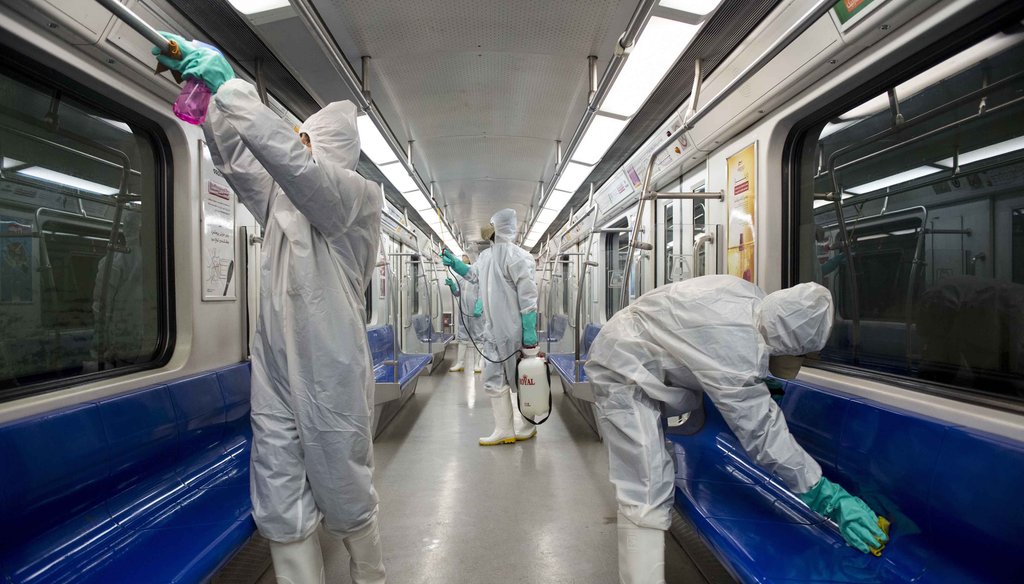

Our only agenda is to publish the truth so you can be an informed participant in democracy.
We need your help.


Workers disinfect subway trains against coronavirus in Tehran, Iran, in the early morning of Feb. 25, 2020. (AP)
Preliminary research indicates that COVID-19 can live for up to three hours in the air, four hours on copper, 24 hours on cardboard and three days on plastic and stainless steel.
Health officials advise people to wash their hands regularly, avoid touching their faces and disinfect their homes daily to prevent the spread of the coronavirus.
The No. 1 thing Americans can do to prevent the spread of COVID-19 is wash their hands. That’s because you can contract the virus by touching surfaces that have the respiratory droplets of an infected person on them.
But how long can coronavirus germs live on those surfaces? An infographic from KIRO-TV in Seattle offers some clarity.
According to the graphic, which was published March 18 on Facebook, the coronavirus can live for "up to 3 hours in the air, up to 4 hours on copper, up to 24 hours on cardboard up to 3 days on plastic and stainless steel."
The post was flagged as part of Facebook’s efforts to combat false news and misinformation on its News Feed. (Read more about our partnership with Facebook.) But in this case, the latest research backs it up — so keep washing your hands and disinfecting your home.
The graphic cites an article published in the New England Journal of Medicine on March 17. Researchers tested how long the coronavirus, formally called SARS-CoV-2, lived on five different surfaces: aerosols, plastic, stainless steel, copper and cardboard.
"SARS-CoV-2 remained viable in aerosols throughout the duration of our experiment (3 hours)," the authors wrote. "SARS-CoV-2 was more stable on plastic and stainless steel than on copper and cardboard."
Aside from air, the worst surface for the virus is copper; researchers could only detect viable virus particles there for up to four hours. On cardboard, they could not detect any after 24 hours. The coronavirus lives the longest on plastic and stainless steel — up to three days.
It’s worth noting that the article is not a peer-reviewed study, and researchers tested the lifespan of SARS-CoV-2 in a lab setting. But their findings reflect what others have found about the potential longevity of the coronavirus outside the body.
An article published in the Journal of Hospital Infection in March reviewed what other scientists have found about how long human coronaviruses can survive on different surfaces. The authors found that viruses like Severe Acute Respiratory Syndrome (SARS) and Middle East Respiratory Syndrome (MERS), which are both similar to COVID-19, could live for a couple of days on steel, plastic, wood, paper and glass surfaces.
What about money, which many Americans handle every day? The World Health Organization advises people to wash their hands with soap and water after handling banknotes, coins and credit cards.
The Journal of Hospital Infection article says human coronaviruses could live on paper for anywhere between one to five days. The U.S. Dollar is made up of 75% cotton and 25% linen, as opposed to wood pulp, which is the base for most paper.
Still, you’re probably safer handling coins. The New England Journal of Medicine article found that COVID-19 can only survive for up to four hours on copper, which is what quarters, nickels and dimes are primarily made of. Ironically, pennies are made primarily of zinc, although they have a copper exterior.
Based on the information available, KIRO-TV’s infographic is accurate. But we’ll issue a small note of caution because the study has not been peer-reviewed. Mostly True.
CNBC, "Can going cashless prevent coronavirus spread? Here’s what the WHO wants you to know," March 6, 2020
Facebook post, March 18, 2020
Journal of Hospital Infection, "Persistence of coronaviruses on inanimate surfaces and their inactivation with biocidal agents," March 2020
New England Journal of Medicine, "Aerosol and Surface Stability of SARS-CoV-2 as Compared with SARS-CoV-1," March 17, 2020
PolitiFact, "Stop sharing myths about preventing the coronavirus. Here are 4 real ways to protect yourself," March 5, 2020
U.S. Bureau of Engraving and Printing, How Money is Made - Paper and Ink, accessed March 19, 2020
U.S. Mint, Coin Specifications, accessed March 19, 2020
World Health Organization, "Is there risk of being infected with the new coronavirus by touching coins, banknotes or credit cards and other objects?" accessed March 19, 2020
In a world of wild talk and fake news, help us stand up for the facts.
